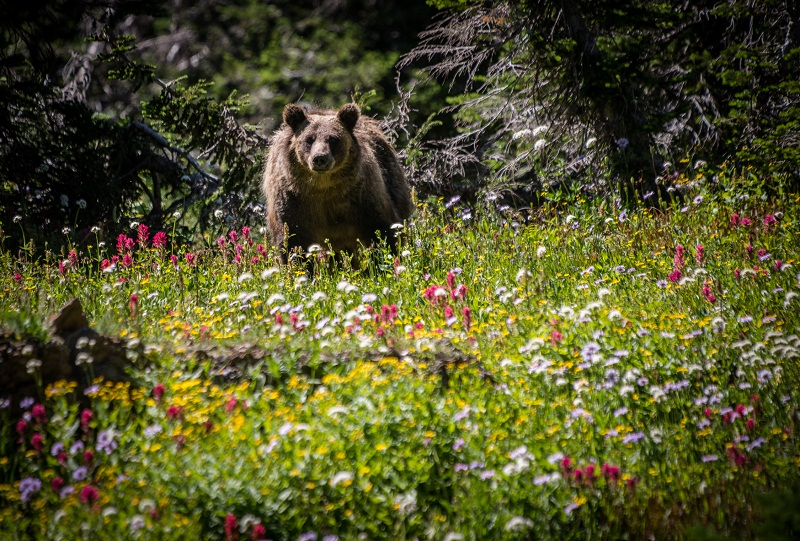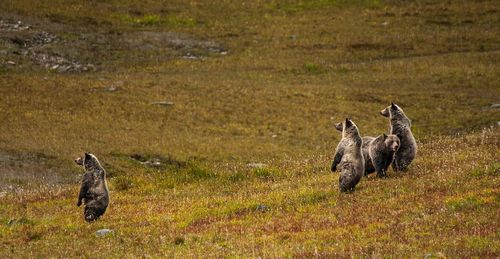Taking Bearings on Yellowstone Grizzly Bear Delisting
“Where grizzly bears thrive, so does wilderness. We oppose the delisting of grizzly bears from the Federal List of Endangered and Threatened Wildlife, stripping critical protections from grizzly bears in the Greater Yellowstone Ecosystem. Now is not the time to gamble with our landscapes and our species – we are lucky that this unique state of nature can still exist in our country, and we realize more and more the value that it brings – for the environment, ourselves, our families, and communities.” Patagonia. Cover featured image by Steve Ogle.
The U.S. Fish and Wildlife Service recently announced its plans to remove Endangered Species Act protections from the Yellowstone grizzly bear. Patagonia along with many other environmental NGOs and citizens are taking a stand against this ruling and demanding continued protections for this iconic population of grizzly bears in our Nation’s first National Park. Grizzly bear activist and expert, Louisa Willcox, explains why delisting would be a historic mistake. Photo: Steven Gnam
Grizzly bears have an interesting way of focusing our attention. They tend to illicit different reactions from different people. In grizzly country, the snap of a twig or the sight of an elk carcass strikes fear in some and excited anticipation for ot hers. With grizzlies around, our experience of nature is heightened. Every year visitors from across the world flock to Yellowstone National Park to see grizzly bears and other wildlife species. Grizzlies hold an immense amount of value, not just from tourist dollars but to many they hold spiritual and cultural significance. This is why the current debate about whether or not endangered species protections should be removed from Yellowstone’s grizzly bears matters to everyone.
The passage of the Endangered Species Act (ESA) in 1973 represented a pendulum swing away from the slaughter of wolves, bison, grizzly bears and other species, to one of more balance in managing our relationship to wildlife. Under the ESA’s umbrella, the status of grizzly bears has slowly improved since the time of listing in 1975. Numbers have probably doubled. Without these protections, grizzly bears would likely have been relegated to just a few bears hanging on in the confines of Yellowstone Park.According to experts, we still have grizzlies in Yellowstone in part because of its vast parks and wilderness, but especially because the ESA stopped sport hunting, reduced availability of human garbage and foods, cut back grazing of domestic sheep on public lands, and closed roads. These efforts would not have succeeded without the blood, sweat and tears of public servants with heart, prodded, occasionally, by watchdog environmentalists.
Yellowstone’s current population of roughly 650 to 750 grizzly bears is much smaller than the 2,000+ animals widely considered by experts to be necessary for long-term viability. Altogether, the five remaining grizzly bear populations in the lower 48 states number perhaps 1,500, a mere 1-2% of the 100,000 grizzly bears that once roamed the contiguous U.S. in a range that was formerly 100 times larger. For the last 40 years, the Endangered Species Act has been vital to sustaining Yellowstone’s grizzly bears. Delisting would likely reverse hard-fought gains and push them back to the brink of extinction.
It’s not just environmentalists who don’t want to see 40 years of hard work thrown down the drain. Native peoples see grizzly bears as relatives, teachers and guides vital to their cultural and spiritual health. Not surprisingly, the proposal to delist and permit sport hunting of grizzly bears is anathema to them. So far, 41 Tribes, from Canada to Mexico, have passed legal resolutions opposing delisting and trophy hunting of grizzly bears.
Some ranchers are sympathetic to the bears. Karl Rappold, whose family ranch was founded in 1882, said to an interviewer in 2009: “…before my father passed away in 1986 he told me the only regret he had was that he’d killed so many grizzly bears and that they’d almost become extinct. He made me promise that when I took over the ranch, these big bears would always have a home. So I worked most of my life to make sure that happened.” A
And, with people flocking to Yellowstone in record numbers to enjoy its bears, wolves, mountains and rivers, it is clear that wild nature is the engine driving the economic and cultural well-being of the region. Endangered species such as grizzly bears and their ecosystems are a cause for celebration. Indeed, there is overwhelming support for the ESA in the region and throughout the country. A recent poll sponsored by Earthjustice Legal Defense Fund and Defenders of Wildlife showed that 90% of Americans strongly support the Endangered Species Act. Instead of turning grizzlies over to the tender mercies of state wildlife managers, we should work to create a political system consistent with this reality.
We are blessed to still have country that is big and wild enough to harbor grizzly bears. This includes iconic places like the Greater Yellowstone Ecosystem, centered on our nation’s first National Park. But today, more than ever, the Yellowstone grizzly bear is threatened by a warming climate, ever more humans, incautious big game hunters and isolation from other bear populations. Each of us needs to do our bit, and the government should do its job. That means not removing the safety net of federal endangered species protections and opening the door for trophy hunting of grizzlies.
By Louisa Willcox
TAKE ACTION!
Join Patagonia and tell U.S. Fish & Wildlife that you want continued ESA protections for Yellowstone’s grizzly bears.
Sign the petition at Change.org
Update 3/7/16: Petition updated to Change.org.
To read full article: http://pat.ag/GrizzlyProtection
To read more about proposed delisting rule:
http://www.fws.gov/mountain-prairie/es/grizzlyBear.php
Cover Photo: Thank you Steve Ogle and Patagonia!
https://www.facebook.com/PATAGONIA/




